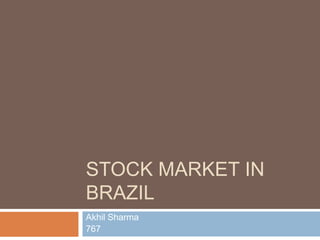Stock market in Brazil
- 1. STOCK MARKET IN BRAZIL Akhil Sharma 767
- 2. History  The BM&FBOVESPA is a stock exchangelocated at São Paulo, Brazil. As of December 31, 2011 it had a market capitalization of US $1.22 Trillion, making it in the 8th largest stock exchange in the world. On May 8, 2008, the São Paulo Stock Exchange (Bovespa) and the Brazilian Mercantile and Futures Exchange (BM&F) merged, creating BM&FBOVESPA. The benchmark indicator of BM&FBOVESPA is the Índice Bovespa.
- 3. Listing Segments ÔÇ® In 2000, Bovespa created three new listing segments, the Novo Mercado (New Market), Level 2 and Level 1 of Corporate Governance Standards, allowing companies to accede voluntarily to more demanding disclosure, governance and compliance obligations. The new listing segments mostly languished until 2004, when a growing number of newly public companies began to list on the Novo Mercado and other segments as part of a capital-raising effort. From 2004 to 2010, the vast majority of new listings on the Bovespa were made by Novo Mercado, Level 2 and Level 1 companies. ÔÇ® The Novo Mercado, Level 2 and Level 1 segments are based on a contractual agreement of the listed company, its controlling shareholder, and its management to comply with specified regulations. In addition, listed companies must submit to arbitration as a method of resolving disputes. The set of protections entailed by a Novo Mercado listing is apparently deemed by market participants to increase the attractiveness of companies. The stock market index of Novo Mercado listed companies (the IGC) has consistently outperformed the broader Ibovespa index since its launch.
- 4. Brazilian equity capital markets: Recent success ÔÇ® The recent success of the Brazilian equity capital markets is attributed to a significant extent to the credibility engendered by the Novo Mercado regulations. In 2007, only the United States and China equity markets had a greater number of initial public offerings. The availabiltity of a "market exit" has also encouraged the development of a private equity industry, a growing Brazilian investment banking market and a thriving asset management industry. ÔÇ® Another side benefit of a thriving equity market has been access to equity financing for the international expansion of Brazilian business.Brazilian multinational companies have used the proceeds of equity offerings to fund a growing number of international acquisitions. Vale, Embraer, Gerdau, Brazil Foods, Marfrig Alimentos and JBS have acquired businesses outside Brazil using the proceeds from equity offerings. ÔÇ® Attractive valuations of Brazilian subsidiaries have led international
- 5. Broad Indexes ÔÇ® IBOVESPA: Total return index comprising the most representative companies in the market, both by market cap and traded volume. It is the benchmark index of S√£o Paulo Stock Exchange. It is the oldest BOVESPA index, and it is being broadcast since 1968. ÔÇ® IBRX 50: Also called Brasil 50, it comprises the 50 most traded equities at BOVESPA. ÔÇ® IBRX: It has the same purpose of IBRX 50, but embracing the 100 most traded equities. ÔÇ® IBRA: Brazil Broad-Based Index, it comprises a wider range of companies, aiming to embrace 99% of all companies already selected for any other exchange indexes. Its main goal is to represent the most relevant companies in the stock exchange. ÔÇ® MLCX: The Midlarge Cap Index shows the performance of the most relevant companies at the exchange, responding for at least 85% its total market value. ÔÇ® SMLL: The Small Cap Index comprises relevant companies who don't apply for the MLCX listing, i.e., heavily traded companies which does not fill the 85% market share criteria. ÔÇ® IVBX: It was conceived as an index to trail the 2nd tier companies, defined as those which trading ranking is from 11th and beneath, therefore not to be classified as blue chips. Nevertheless most of its members are highly relevant companies, needing to comply with high traded volume and market capitalization. ÔÇ® IDIV: The Dividend Yield index, it comprises companies which show the highest dividend yields values in the market, along with a strong trading session participation.
- 6. Sector Indexes ÔÇ® Sector Indexes ÔÇ® IEE: Electric Power Index. ÔÇ® INDX: Industrial Index. ÔÇ® ICON: Consumption Index. ÔÇ® IMOB: Real estate Index. ÔÇ® IFNC: Financial Index (comprising banks, credit card processors, insurance companies, etc.). ÔÇ® IMAT: Basic Materials Index (representing raw materials, pulp & paper, packaging, steel, etc.). ÔÇ® UTIL: Public Utilities Index (electric power, water & sewage, gas, etc.).
- 7. Corporate Governance Indexes ÔÇ® Corporate Governance Indexes ÔÇ® IGC: Corporate Governance Index comprises all companies listed in any of the distinctive governance levels, irrespectively of its market cap. ÔÇ® IGCT: Corporate Governance Trade index filters the IGC components by trading liquidity. ÔÇ® IGNM: The New Market Index congregates all listed companies in the New Market portion of the BOVESPA. ÔÇ® ITAG: The Tag Along Index is composed of equities that offer to his bearer privileged tag along rights compared to those granted by Brazilian law and a minimum trading volume.
- 8. Sustainability Indexes ÔÇ® Sustainability Indexes ÔÇ® ICO2: Efficient Carbon Index is granted to companies who complies with efficient efforts to control GHG emissions and are eligible for IBRX 50. ÔÇ® ISE: Corporate Sustaintability Index is comparable to the DJSI, to join companies tied to environmental, social and accountability goals.







